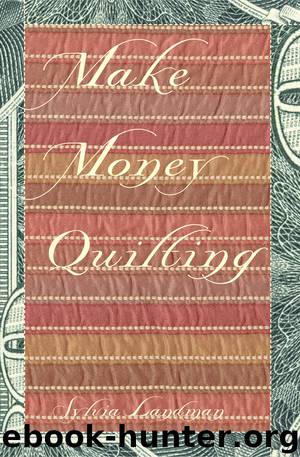Make Money Quilting by Sylvia Ann Landman

Author:Sylvia Ann Landman
Language: nld
Format: epub
Publisher: Allworth Press
Published: 2005-03-15T05:00:00+00:00
Nancy Kirk: Quilt Restoration
“Quilt restoration and repair can be a good home-based business for talented quiltmakers who have a special passion for antique quilts,” says restoration expert Nancy Kirk. “Basic restoration skills are easy to learn through workshops or home study, but a professional restorer will spend the rest of her professional life learning about antique fabrics and quilts, from dating to dyestuffs, fiber identification, material culture at different historic periods, conservation techniques, and more.
“Restoration is generally a part-time business because it requires long, tedious hours of handwork. Most people find that four hours a day is the maximum they can work effectively at the actual restoration. Some time needs to be allocated to marketing, bookkeeping, and customer service, but finding customers is easy once you let it be known that you are doing this kind of work. Many restorers combine a restoration career with appraising, lecturing, or teaching if they want to work in quilt related fields full-time.
“Restorers generally charge from $15 to $65 per hour, depending on their skills. Our 2004 rates are $40 per hour for basic restoration and $50 for intricate embroidery work. We also charge a $40 evaluation fee to inspect a quilt and prepare a written proposal and estimate.
“Most clients are private parties who want a family quilt restored. Sometimes dealers will want antique quilts fixed, but it rarely works out economically to repair quilts for resale, as the cost of restoration will probably equal or exceed the increase in the retail price.
“Most museums will seek conservators rather than restorers to work on pieces in their collections where the goal is to maintain the piece in its current condition and stabilize it structurally. The goal of most restorers is to return the visual integrity of the quilt to what it was some point before the most recent damage.
“Many restorers finish old quilt tops, but must advise people on the options of using antique versus reproduction versus contemporary fabrics. At times, you may be asked to repair a contemporary quilt after a dog has chewed it. The most important thing is to learn enough about quilt history and conservation to know when to walk away from a job because the value of the quilt will be adversely affected by restoration.” Nancy offers her valuable advice to others considering a career in quilt restoration:
Setup
A restorer needs a studio or workspace free from pets and children where client quilts can be stored safely. The work area should be large enough so the quilt can lie flat on a single surface while under repair. Good lighting and ergonomic seating is important, and a well-stocked library is an asset.
Training
Quilt restorers can take workshops, and most learn by doing, working on their own quilts or garage sale finds until they have confidence enough in their skills to work on client quilts.
Marketing
The least expensive and most effective marketing tool is an engraved nametag with your name and the words “Quilt Restorer” on it. Wear it everywhere you go. On every trip away from home, someone is likely to tell you the story of her family quilts.
Download
This site does not store any files on its server. We only index and link to content provided by other sites. Please contact the content providers to delete copyright contents if any and email us, we'll remove relevant links or contents immediately.
On Writing A Memoir of the Craft by Stephen King(4664)
The Doodle Revolution by Sunni Brown(4503)
A Simplified Life by Emily Ley(3969)
Mummy Knew by Lisa James(3521)
Marijuana Grower's Handbook by Ed Rosenthal(3512)
Better Homes and Gardens New Cookbook by Better Homes & Gardens(3371)
Paper Parties by Erin Hung(3308)
Figure Drawing for Artists by Steve Huston(3271)
Draw Your Day by Samantha Dion Baker(3126)
The Genius of Japanese Carpentry by Azby Brown(3039)
Japanese Design by Patricia J. Graham(3000)
The Code Book by Simon Singh(2857)
Lions and Lace by Meagan Mckinney(2845)
Dangerous Girls by Haas Abigail(2839)
The Curated Closet by Anuschka Rees(2802)
How to Make Your Own Soap by Sally Hornsey(2741)
The Checklist Manifesto by Atul Gawande(2657)
The Wardrobe Wakeup by Lois Joy Johnson(2635)
Zero to Make by David Lang(2627)
